Do you need pectin to make jam? I used to think so.
I followed the recipe on the inside of the pectin box slavishly for 7 years before I broke free of the pectin bonds. Every year, my strawberry jam tasted exactly like the strawberry jam of everyone else who wore the Sure-Jell shackles. The jam was never bad, but it was never really mine, either.
Before, jam making was about following rigorous and strict recipes, adding in a ton of sugar to “ensure a good set,” skimming diligently to remove foam and crossing my fingers while timing that one minute of “hard rolling boil” down to the second. That’s what was required by the pectin box master and I was terrified to change a thing lest I ruin an entire batch of jam.
Now, I’m a liberated pectin-free jam maker, and I’d never go back.
When I make preserves now, I work with my fruit, tasting and adjusting things like sugar and spice based on fruit ripeness and variety and juiciness and what sounds good. I reduce water out of my preserves to get the consistency and depth of flavor I’m looking for. I reduce sugar levels down to one-forth or less of typical levels and still produce a preserve that is full of sweetness and sunshine. My jams, each and every batch, are creative and unique.
The only things I slavishly adhere to now are sanitation and processing standards, and acidity levels, which ensures that while I’m having fun and getting to be creative jam-girl, I’m also producing a product that is faultlessly and impeccably safe for my family and friends to enjoy.
Here’s how I make high-acid fruit preserves. All photos in this series are from a batch of Apricot Jam with Lime, Ginger and Tequila that turned out so good I said, “Sweet baby Jesus!” upon tasting it. Except I pronounced it “Jesús” in the Spanish way. You know, in honor of the tequila.
As I mentioned in yesterday’s post, I think of the flavorants I add to my preserves as either “Dry Zing” or “Wet Zing” because they add that zing of flavor I’m looking for and they are either dry (herbs and spices) or wet (boozes, extracts, vinegars, etc.). If you missed it yesterday, you can download a Flavor Maker Chart of Wet and Dry Zing suggestions for all the fruits I typically jam on the Downloadables page.
Basic Pectin Free Preserve Formula
makes about 4 half-pint jars of preserve
- 2 pounds washed and appropriately prepared fruit (Peel, seed, chop, etc. Weigh after preparing.)
- 4 to 8 oz (a gently rounded ½ to 1 cup) organic sugar
- 1 tablespoon freshly squeezed lemon or lime juice
- ¼ teaspoon Dry Zing (optional, see Flavor Maker Chart for suggestions)
- 1 tablespoon Wet Zing (optional, see Flavor Maker Chart for suggestions)
Method
For every 2 pounds of prepared fruit, add 4 oz. sugar (a gently rounded half-cup is 4 oz.) and combine in a large bowl. Scale as necessary; I usually do 6 pounds fruit and 12 oz. sugar, which gets me about 10-12 half-pint jars of jam, depending on how much I reduce the jam. Cover fruit-sugar mixture and transfer to the refrigerator to macerate. Let sit overnight, or up to 24 hours.
In truth, I’ve left my sugared fruit for a few days in the fridge and there’s never been any harm done. That’s another reason I like this method. Sometimes it’s very nice to be able to put fruit “on pause” for a day or two until you can get it in a jar.
After 12-24 hours, the sugar should be mostly dissolved and the fruit should have released quite a bit of juice.
Prepare jars and lids as for standard water bath canning. Keep spotlessly clean half-pint or pint jars warm in a large pot of simmering water. Have new lids and clean bands ready. Have a clean lint-free towel or paper towel available to wipe jars. If you are new to water bath canning, I recommend you read this to get a feel for the basic procedures and precautions you must take to ensure you are creating a safe product.
Transfer the fruit, sugar and all the juices to a large, very wide, shallow pan. Something like a huge saute pan is good. You want as much surface area of the preserve exposed as possible to allow for the fastest evaporation of excess water from the preserve. If you have more fruit than you have pan, divide your fruit and juice as evenly as possible among pans, or work in batches.
Bring the macerated fruit and juices to a simmer over medium heat. Stir frequently, you do not want your fruit to scorch.
When your fruit has softened but not fallen apart, add in your lemon or lime juice, 1 tablespoon for every 2 pounds of fruit initially prepared.
Also add in your Dry Zing component, if using. Use ¼ teaspoon for each initial 2 pounds prepared fruit unless you are using a really potent spice like cloves. Then use less. Stir.
At this point you have to decide what kind of texture you want your preserve to have. If the texture in the pan is too chunky or the pieces are too large, crush your fruit with a potato masher or puree as desired with an immersion blender. I like a quite chunky texture but this is entirely personal.
Take a small spoon of preserve, including some fruit and a bit of syrup together if your preserve is chunky, and taste them. Is your jam sweet enough? Does it need more sugar?
If your preserve is tart at this point, add a bit more sugar, up to an additional 4 oz. (another rounded ½ cup) for every 2 pounds of fruit initially prepared. You may need even more sugar if you are cooking something quite tart, like quince, currants or gooseberries. Trust your judgement. If you think the preserve needs more sugar, add it. If it is sweet enough to your taste, leave it alone. Remember that as you cook the preserve longer the flavors, including the sugar, will taste more concentrated. Stir everything gently but consistently.

When your preserve is glossy, a bit darkened and looks slightly thickened, transfer a bit of jam to a cool (ideally refrigerated) plate. If you run your finger through a dollop of jam on a cool plate and the finger mark remains visible or runs together only very slowly, the jam has reached the soft spoonable stage I prefer.
At this point, add the Wet Zing flavoring if desired, using 1 tablespoon for every 2 pounds of fruit initially prepared. If using a flavor extract, like vanilla or almond, use only 1 teaspoon and adjust to taste. Strength of extracts varies considerably by brand and you don’t want to overdo it. Most of the Wet Zing components have flavor compounds that are quite volatile and should be added towards the end of the cooking time lest their flavor evaporate away.
Stir well, taste jam one last time (clean spoon, please!) and make any final adjustments to the sugar level. You may also add additional citrus juice at this point, if desired. If a preserve tastes like it just needs a little something, usually that something is a few drops of lemon juice. No kidding.
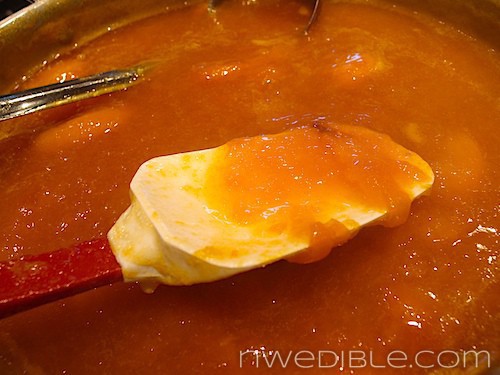
At this point, keep your preserve at a bare simmer and proceed to fill and lid your jars as per standard water bath canning procedure. Remember to wipe the rims of your jars before setting lids! Process half-pint or pint jars of jam for 10 minutes at a full rolling boil.
A word about texture: a jam made in this pectin-free manner will not give you the firm, high mounded spoon look of a pectin jam. The thickness does not come from gelling the moisture in the preserve, but from reducing excess water out of it (this is why using a wide, shallow pan is so important).
Preserves made this way will give you a French-style, soft jam, thicker than syrup or ice cream topping but not so thick as to allow a spoon to stand upright in the jar, as is the case with many pectin-set jams. I find this texture to be more sophisticated, frankly. The depth of flavor and slightly caramelized tones that come from lower water content, longer cooking and reduced sugar content can’t be beat.
And because you are liberated from the chains of the pectin recipe you can have some fun with creating flavors all your own. The only caveat is that your jam, to stay safely water bath can-able, must stay high-acid, with a ph of 4.6 or less.
Have you made pectin-free jam or are you dedicated to the box?
168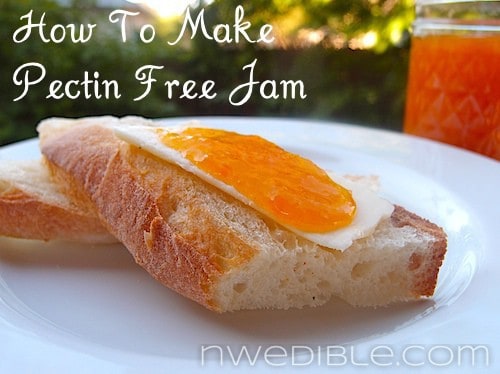
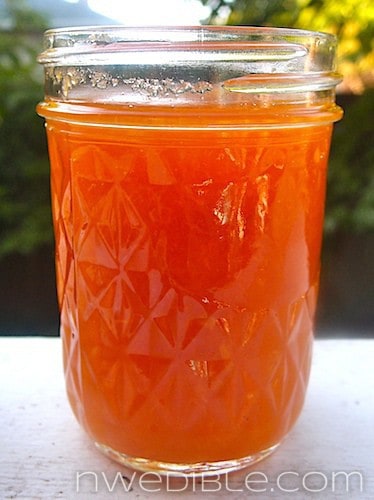
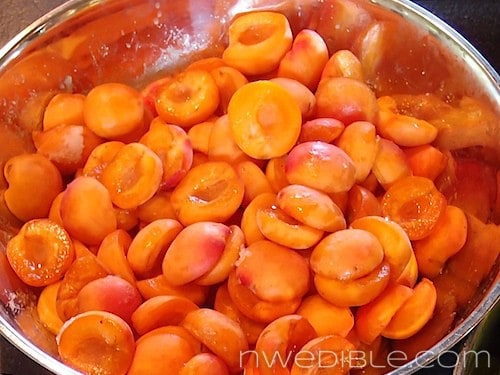
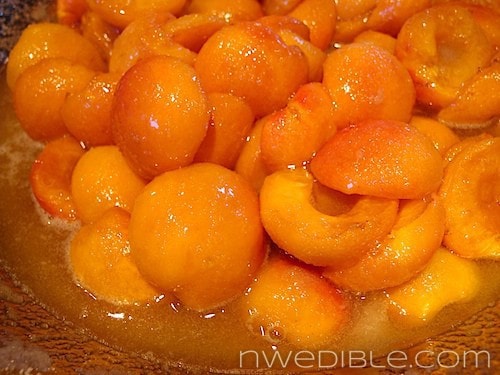
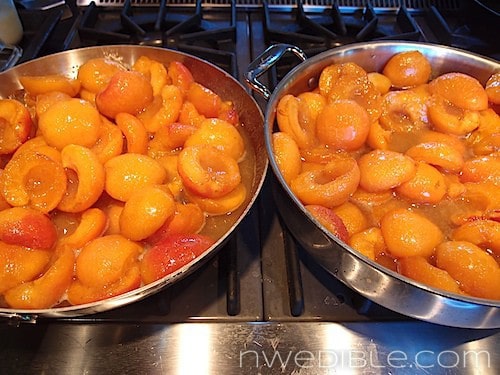
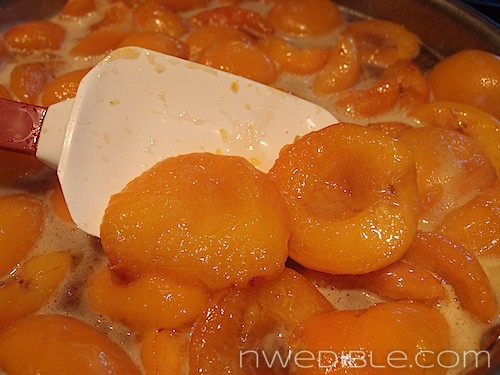
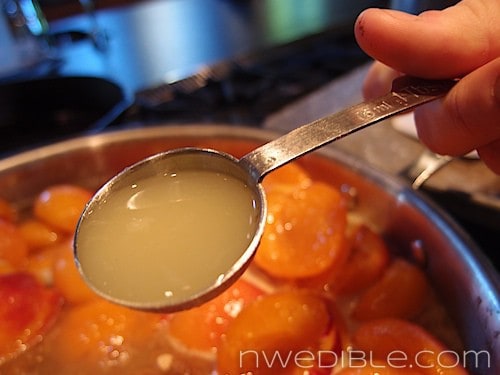
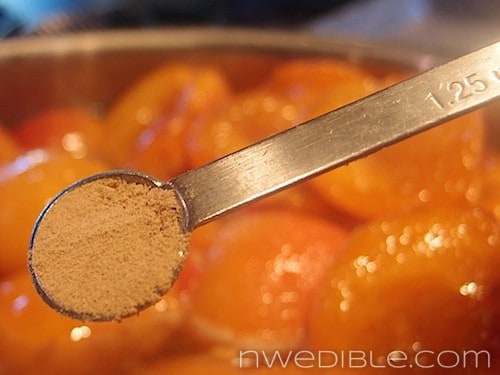
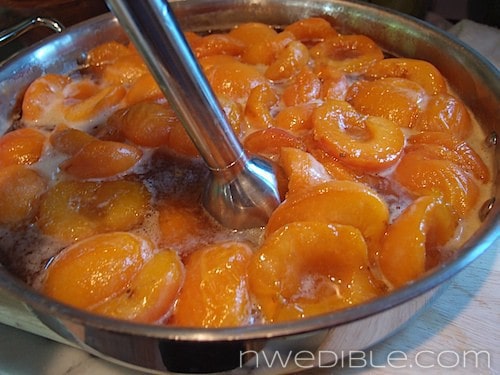
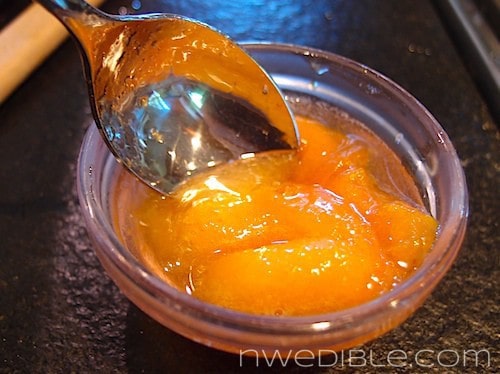
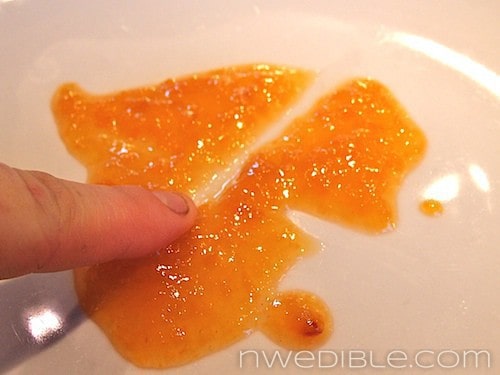
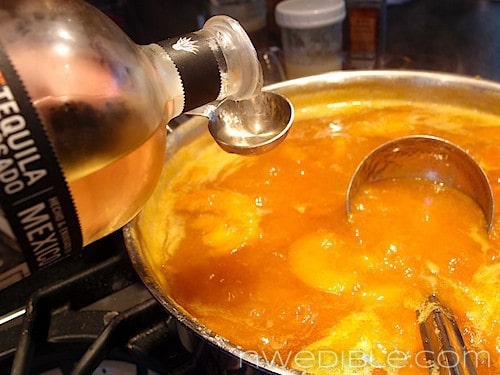
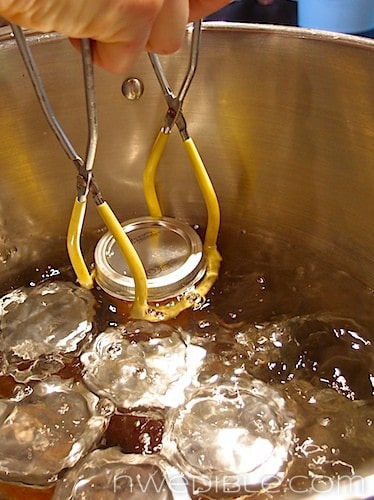
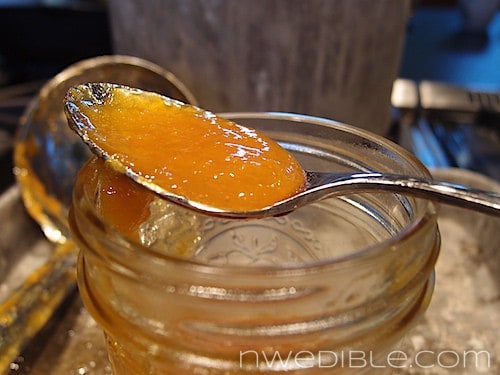


Last year, pectin. This year, not so much. We are primarily berry jam eaters, so I’ve cultivated a lot more feeling for when my jam is thickening. The feeling of spoon stirring resistance that tells me its going to set sans pectin.
Adjusting sugar levels though, that is welcome news to me. We use lower sugar levels than most (Marisa @ Food in Jars is pretty good about this), but thanks for the 2lbs – 1/2 C. tip. That’s a nice rule of thumb.
If you want Ill lend you Preserving with Friends, Harriet DVD on food preservation. It made a big difference in how I look at this stuff. I use as little sugar as I can get away with. Often the preserve needs less than we’d think. But I do a full 10 minute process instead of 5 b/c I know traditional 1:1 or even 2:1 sugar:fruit ratios do have a preservative effect on jam.
This is a wonderful tutorial. Do you use a pH meter? I never would have thought of it, but a friend loaned me Paul Virant’s “The Preservation Kitchen” and he’s a big advocate of both making your own canned goods and having a pH meter if you’re straying from known recipes.
I, so far, have just been a pectin-using jam-maker. This year, I am making no jam, as we have jam from years back that needs to get eaten. I’m sad, actually, but maybe it’ll give me some time to think about what new flavors I can create.
I have ph strips which I do some testing with but won’t rely on if the preserve is borderline low acid. They arent quite reliable for that. I don’t have a ph meter but I’ll look into them. I’ll be talking about how not to kill yourself with your food preservation later this week. Now that I understand what’s really going on with canning related toxicity issues I am much more confident making reasonable adjustments to high acid preserves.
I’m really looking forward to that post!
It’s good to know (of?) someone who uses pH strips for testing. I think my experience in biology teaching labs would make me pretty leery of doing the same without the knowledge that someone else has done so and has a good sense of how to use them safely. They’re not the most accurate or precise things out there, but if they get the job done it seems like a good start.
Thanks!
I am interested in trying th PH meter. I make my own jam recipes as well and am always a bit concerned that I may not have the proper ph.
Did Paul Virant recommend a specific PH meter? I just checked Amazon and there are many available at several price points.
As I recall, he did not. Unfortunately, I no longer have the book so I can’t double check.
I suspect even a basic pH meter would be fine, so long as you keep it clean and calibrated. I haven’t looked into them yet, myself, so I haven’t seen what I might want, even though I know that’s where I’m eventually going.
I’ve never used added pectin in my jam, but I use a lot more sugar than in this recipe, so it does reach a jel point. In my strawberry jam I add plenty of lemon juice for the pectin, but the apricot usually has enough pectin in the fruit already, as long as it’s not overripe.
I like the sound of your soft preserve. I’ve never done the canning water bath thing, so would have to learn that, before changing my ways!
Do you make freezer jam then?
Inspiring! My fingers are purple because this article incited a wild drive for homemade soft-serve sophisticated-like blackberry-lemon-vanilla jam. I’ll be putting it up tomorrow or Thursday! Most of the berries even made it into the colander!
So. Um. When does the prickling feeling from the thorns go away? 😉
Plot – depends how far into the bushes you went. My son was born in early September and I have a photo somewhere of my 8.5/9 month pregnant belly COVERED in blackberry scratches. I felt terrible when I saw what I had done, like somehow my little boy would be born with bramble scratches on his face. He wasn’t. 🙂 That said, if you have a really prickly feeling, make sure it’s just blackberries you are wading into – they often grow together with stinging nettles. I always wear long sleeves, long pants, a hair covering and heavy duty boots when I go blackberry picking. I look like an idiot in 85 degree weather, but that’s just how it goes. 😉
Or you guys can grow thorn-less blackberries like I do.. they are twice as big and sweeter then the wild ones.. and no scratches. 🙂
I love your blog Erica.. I just stumbled upon it while looking for pectin-free recipes.. and found some good tips and love your flavor maker chart.. I found it just in time as all my fruit trees and berry bushes are coming on strong this year. Thanks so much!
Not to be a pill, but even thorn less blackberries have a bad side, though it takes its time. Try as you might to pick every berry, the birds WILL get some and some WILL fall. Those WILL germinate and the plants WILL have thorns. Still tasty though.
None of you appear to have the problems we did in picking blackberries underneath the Manchac overpass; venomous snakes and the possibility of finding a person whose remains were secreted there (Murderers, far from being fearless, seem to just chuck the corpse and run for fear of the snakes mentioned above. Despite the financial reward of a finder’s fee, we were always feeling a delicate frisson of dread as we snatched our fruit. Also wasps.)
I’ve been experimenting with no-pectin jams off and on– I generally prefer the texture of the no-pectin variety, but I’ve done some of both this season. I am getting a case of nectarines this week, so that’s next on the list.
Hi Anne-Marie,
How did your nectarine jam go? I’m about to make some myself as a first-time jam using this method, and any notes would be appreciated.
I have to say, I’ve never used pectin when making preserves. I like your process though. Never thought of using the immersion blender.
I’ve only made freezer jam up to this point because I thought the sugar was needed for water bath canning. I usually use a 4 cups of fruit to 1 cup of sugar ratio and I think it just tastes so much fruitier with less sugar. I may have to try your method as my freezer’s getting a bit crowded.
The sugar is needed to set the pectin if you follow the box recipe, not for water bath canning itself. Assuming you follow other preservation standards, like ensuring a ph lower than 4.6 (almost all fruit is safely below this) and processing for the full amount of time, the added sugar plays basically no role in the safety component of the jam. You can, for example, can fruit (peach halves, etc) in just water, no sugar at all. It’s just that the flavor and texture isn’t very good. In the old days, when the jam wasn’t water bath processed, a lot of sugar was needed to act as a preservative against molds, yeasts and other beaties. A LOT. I’m glad we can cut back now. 🙂
This is a really helpful tutorial–thanks! I don’t generally make jam–my canning is usually all pickles and tomato sauces–but I may just give it a try now. 🙂
This is how I have been making jams the last couple of years! I am ready to try your “zing” options!!! Woo Hoo!
Hi Erica! I’ve never liked the idea of using the amounts of sugar called for in the Sure-Jell recipes. I’ve only started making jams in the last couple of years and mostly they’ve been long-cooking, low-sugar soft spreads like what you described in the post, but I always thought that meant I was doing it “wrong” and therefore I put them in the freezer rather than can them, for safety’s sake. It’s so exciting to know it’s possible to can this kind of spread, which is what I prefer. Thanks!!
Hi Saskia! Yes, you absolutely can water bath can your jams assuming you haven’t added acid-lowering ingredients like onion or peppers or something to your preserves and the ph is safely below 4.6. Almost all fruit is safely acidic enough that water bath canning is safe, regardless of the amount of sugar, assuming all other safety precautions have been followed. Now that you know you can make a lot more because you won’t be limited by freezer space! 🙂
I’ve done both with and without pectin. Both methods have their pros and cons. I like knowing my jam will set with pectin, but I find it often gets too thick for my liking. Without pectin, I’m always nervous about exactly when to stop cooking the fruit down. One time I decided to do it by temperature, but I forgot to adjust for altitude. It NEVER got to the right temp and I ended up with 4 pints of peach candy. lol.
Hazards of mile-high living, eh? 🙂 Peach candy doesn’t sound too bad, though!
I also live a mile high in Colorado and sure does making canning (and baking) a challenge! I wound up with Plum Cement…tried for butter….last year trying to get the temp and gel point correct lol!
Last year was the first year I used pectin and actual recipes (I planned on giving some as gifts, so I figured I should try to do it “right” for a change).
I did NOT enjoy the process or the product. I did make a pretty killer pepper jelly with thai dragon peppers and juice from our grapes, but I ended up just kind of sprinkling a little pectin in until it reached a good consistency.
The apricots with tequila sound AMAZING! I’ve done apricots with a bit of added pineapple juice and rum (which was divine when frozen and blended with some coconut whip)
That’s how I feel too. The box directions just put me on edge. I don’t like that. It’s jam, not disarming a bomb – we should be able to relax a bit. The process I describe here, even though it seems kinda intricate when I photograph every single step, is actually much more languid and laid back once you do it. Though I’m not sure you could do a true jelly without additional pectin of some kind. Your pepper jelly sounds like it would be great glazed on chicken or fish.
I’ve made crabapple jelly plenty of times with no store-bought pectin – if you save your citrus pits you can use them (in a muslin bag so your jelly doesn’t end up full of pits!) instead of pectin.
how long can you save the pits and how do you store them. (example: have lemon pits from juice squeezed in April. could I have kept them to use now?)
I love using the immersion blender, especially on those pesky strawberries. Have tried making pectin from thinned apples, but so far no success. Will try this method soon- meaning after the maceration, of course. : )
I think the apple pectin trick is to simmer for approximately a decade in water, until it’s like runny apple sauce, and then strain very slowly through cloth. You probably know this, but you can test the strength of cooled apple pectin by dropping it into a bit of rubbing alcohol and seeing if it clumps up. The Preserving with Friends DVD I reviewed last year has a nice explanation of making apple pectin. It’s a good thing to know, but honestly, I’m just fine with skipping that step and making a softer set jam. I’m not a big fan of jelly, but I suppose if I was I would try to perfect homemade pectin just for that.
Two comments that I think will benefit all here. I have been making jam for years and years…used to make it with store bought pectin, but they now have GMO ingredients in them and we went non-GMO over a year ago, so I went looking for alternative methods.
Last year, I threw out all the jam I’d made in the past couple of years where I’d used GMO beet sugar. I sniffed the jars as I opened them, and each jar, no matter what kind of fruit was used had an odd chemical smell in them. I switched to sugar made from sugar cane last summer and went looking for recipes to make jam without store bought pectin and that was safe (acid wise). Found the wonderful recipe for “strawberry jam with homemade pectin” see link below and this site and have completely changed the way I make jam–“fresh” non-GMO lemon juice and homemade apple pectin. The jam was so-o good and so-o simple to make no matter what kind of fruit you use that I’m never, ever going back to store bought pectin.
1. Add the juice of one lemon to every batch of jam–no matter what flavor. The fruit flavor will be brighter and you eliminate not acidic enough risk. Just buy a couple of bags of lemons before you start.
2. We have apple trees and making homemade apple pectin is one of the easiest things in the world. I recommend peeling the apples with a “Back To Basics Apple/Potato Peeler,” because it makes quick work of it if your apples have been sprayed with insecticides, you won’t have to worry about that so much.
Try this fabulous non-GMO recipe idea:
http://foodpreservation.about.com/od/Preserves/r/Strawberry-Jam-With-Homemade-Pectin.htm
I make the pectin from peeled apples, going to try to grow organic apples this year, like the recipe here:
http://foodpreservation.about.com/od/Preserves/r/Homemade-Apple-Pectin.htm
Enjoy!
We are pretty health conscious we eat non GMO and organic . When I set out make raspberry and Marionberry jam I researched for a couple days and I knew sugar was not something I was going to use
I like the idea of making your own apple pectin, , Just a side note, my naturopathic doctor told me that apples that have been sprayed with pesticides will absorb the spray so it is in the apple, so the level of toxicity is greater than, other fruits. I found NON GMO organic pectin. And I made raspberry jam with coconut sugar which is so much better and healthier it also doesn’t caused your blood sugar level to skyrocket .
Taste great.
My super-secret recipe? Strawberry-rosemary-sage jam, with cider vinegar instead of lemon juice.
Fabulous. I knew I wasn’t the only weird jam girl out there. Do you ever have an issue with sage turning bitter after canning?
nice presentation
Thank you!
What do you know about making this kind of pectin free jam with honey rather than sugar?
Same basic process. The flavor of honey comes through. Use a mild honey if you can. Something like knotweed will overwhelm the milder fruit flavors of strawberry or apricot I’d imagine. You’ll have a bit longer simmer because of the moisture content of the honey. I’ve never run into this, but theoretically crystallization might be an issue…maybe? But otherwise, it’s not a problem to use honey. Honey and the light stone fruits (peach, apricot, etc.) are fab together. I did apricots in a ginger honey syrup last year and they turned out great. You can also do part sugar part honey. If you do a preserve with honey, don’t feed it to infants under 1.
Good point..glad my kids are all over 1!
I know honey is sweeter than sugar, so do you have a general rule of thumb in terms of amount for subbing honey for sugar? I’m dreaming of a raspberry-honey-lemon jam
Well, I’m wishing I had read your post earlier! I made my very first jam and jelly today. I used the pectin box. I’m VERY intimidated by the canning process in general. I’ve never been very good at following directions/recipes which is why I’m usually very free-spirited in the kitchen, but I’ve seen so many warnings about straying from the recipe when it comes to canning that I’m afraid to be creative. And how, exactly, am I supposed to know if the ph is right, or not?
On the bright side, though, my pepper jam turned out really well and I loved using peppers from my garden, including jalapenos which FINALLY have some heat to them. I’ve been growing them for years, but they’re always too mild for my taste, so this year, I planted a habanero nearby.
Well, don’t feel bad because if you had asked I would have said pepper jelly/jam probably requires pectin anyway and DEFINITELY requires an approved recipe anyway, because you are playing with low-acid foods and need to get the right amount of lemon or vinegar in there to make it safe for water bath canning. 🙂 Congrats on your spicy peppers, I’m still crossing my fingers for my jalapenos.
I have a ton of concord grapes, and was thinking of making pectin-free jam with them. I always made grape jelly with my mom when I was a kid, but she swore by pectin and I always sort of thought the jelly that she made was too sweet and a little gross. Do you have any advise? Would you mash them up first and then let sit with the sugar? At what point do you strain out the seeds? Any ideas would be great, thanks!
I am not a big maker of grape anything except wine….so I refer you to this, which seems to indicate you can made a damn fine concord jam without pectin: http://chefinyou.com/2011/10/concord-grapes-jam/. Let me know how it turns out!
I’ve made grape jelly without pectin and with low sugar for about five years. The taste is incredible. The key is to use high pectin fruit along with the regular grapes. I’ve found that 10-15% of under-ripe domestic grapes or half wild grapes or a few apple slices will add enough pectin to set the jelly. You have to cook it down, as Erica did in this post’s recipe, and I test it using a spoon. When it flows from the spoon in a sheet and not drops, it is ready to can. I found that method in an old Joy of Cooking cookbook.
Dude, I totally took that apple advice and ran with it. I made blueberry jam tonight and blueberries tend to be so juicy I was nervous about how long it would take to cook down. So I grated up a peeled quarter-apple; it cooked into mush in the juices of the blueberries and made a nice thick jam. Who knows, maybe it would get thick anyway, but it made me feel better!
I don’t actually like blueberry jam much by itself – I find it too sweet, though the hubster loves it – but jam with homemade yogurt is to die for, and blueberry is one of my FAVORITE flavors for that. I used to make up the equivalent of blueberry pie filling to mix in, but it involves cornstarch and I don’t think you can can that.
So now, I can make up blueberry jam with this method, and come Christmas give away blueberry jam with homemade yogurt to all the rellies. OM NOM NOM.
I have used clearjel, which is a type of cornstarch, instead of pectin, to thicken jam, then canned it. Make sure to get the heat stable type, and it should work just fine.
I just discovered your site and I love it! You are reinvigorating an old crunchy mama. After years of just getting done (homeschooling 9 kids, canning hundreds of quarts a year and working as a midwife and nurse), I am enjoying the creative thinking you have inspired in me. Thank you!
Thanks so much, what a lovely comment! Um…I have no idea how you aren’t basically microwaving dinner in a plastic tray every night with that work load, so if the worst you’ve suffered is a little creative fatigue I’d say you’re doing pretty freakin’ amazing. Thanks for being an inspiration!
Sally Wise, an Australian woman who’s written a few preserving books makes her own pectin from apples. I think she has a few other recipes in her Year in a Bottle book, but on her website she has a recipe for Crab Apple pectin http://sallywise.com.au/blog/2011/03/02/crabapples-the-not-so-humble-fruit/
Thanks for the link – homemade pectin is an awesome option for people who like a firmer set. I like to make it from the thinnings and clean drops of my apple trees in late spring/early summer. Another option is to throw a few tart chopped up apples or cores and peels in a mesh bag and simmer that with whatever lower-acid fruit you are preserving. But it is very nice to have proper apple pectin.
Great post, thanks. Has anyone tried Pomona’s Universal Pectin? According to the directions you can use much less suger than with Certo. It is made from extracted citus peel and uses calcium rather than suger to make it jell. I don’t use pectin for jam, but I do use it for my hot pepper jelly. I will be using the Pomona’s today for the first time. I also use mostly our own honey instead of suger and often use various citrus juices, grapefruit and lime, in addition to lemon juice for the acid.
Thanks. I know a bunch of my readers like Pomona’s. I have never used it, mostly because once I discovered I didn’t have to buy pectin I just…stopped buying pectin. But I hear great things and would definitely look into Pomonas if I were feeling compelled to make a jelly of some kind. Let me know how it turns out for you.
I don’t like Pamona’s because I always wound up with this nasty rubber cement consistency to my jams/preserves using Pamona’s pectin. For jams I prefer to use your method. I do make a totally sugar free (sweetened with apple juice only) using Ball RealFruitTM Low or No-Sugar-Needed Pectin. This is for fruit jams I use to mix into individual jars of homemade yogurt. I made 32 lbs of no sugar cherry jam last year and I used the last of it this morning. I’m picking up 54 lbs of cherries today to make next year’s worth of low sugar and no sugar jams. Your method will be for the low sugar and again I’m using the Ball for no sugar yogurt mixes.
Evey – I use Pomona’s quite frequently. I’m moving away even from that, but I still think it’s a great product. I use it when I want a firmer set than I can get with straight reductions (what Erica is using here) or if I want to keep the fruit minimally cooked.
A few observations and tips:
– The consistency of Pomona’s is a bit different than “regular” pectin. Kind of more jello-y, if that makes sense. Just something to keep in mind.
– I prefer softer-set jams. While I initially started using Pomona’s for the reduced sugar option, I quickly figured out that you can also adjust the calcium water/pectin powered amounts you use to get the kind of set you prefer. The amounts they call for in the box inserts result in jams that are quite firm. I usually go with half or less of what they suggest.
– With no-pectin and Pomona’s pectin preserves it can take several days to see the full set on the product. I’ve never had a product not set up, but I have seen a change in consistency from right after cooling to a couple days later.
– Once you open a jar it will not keep as long in the fridge as jams made with regular pectin. Sugar is a preservative, so low-sugar jams don’t keep as long after opening. If you don’t go though jars very quickly you might want to consider canning the product in smaller jars.
– If you belong to an Azure Standard co-op you can get Pomona’s in bulk. 1 lb is $43.50, but if you decide you like using it it is a lot cheaper than the boxes and will last you approximately forever.
Thanks for chiming in, Lily!
Thanks for writing about jamming without pectins. *Love* your wet and dry zing chart. FYI, try Cherry Amaretto jam; it’s a really good flavor combo.
As for Pomona’s, Lily made some great points. You can adjust the set of Pomona’s Pectin by adjusting how much calcium water you add. If you want jam for PBJs, a little Pomona’s helps you add enough firmness to be sandwich-friendly without having to have a ton of sugar in it. For many jams I don’t care about firmness and don’t need to use pectin at all, but for jams for PBJs, I do. Pomona’s helps that happen but still lets me adjust sugar and set to taste. Nice.
Another great thing about Pomona’s that no one has mentioned is that it doesn’t lose its effectiveness over time. With other store-bought pectins, the effectiveness of the pectin diminishes year to year. With Pomona’s, a low methoxyl pectin, you can buy in bulk from Azure or wherever and not worry about how long it takes you to use it. I have more info about the pros and cons of various pectins here:
http://wellroundedmama.blogspot.com/2012/09/canning-pecking-about-pectins.html
This looks so delicious! Love the pics – I will be making this!
Thanks!
This has been great to read! Thanks. I have been wanting to try diffrent options when it comes to making jam, especially ones that have more fruit flavour, and less sugar.
I have a few questions, if I were to boil the mixture longer, would I get a thicker consistnacy?
and second, I dont have a ph tester of any kind, is there any home made tester I could use? Or just stick with your rules from your write up?
I am eager to try new things out, and love the flavour chart.
Thanks
Hi Lauren, yes boiling the mixture longer will get you a thicker consistency. I don’t know of a DIY ph tester. I’d be concerned about calibration on something like that. Your safest course is to stick to firmly high-acid fruits for water bath canning. I add a measure of personal reassurance by adding small amounts of lemon or lime juice or citric acid to anything, even fruits, that I can. Here’s a list of acid/low acid foods: http://pickyourown.org/food_acidity.htm
I enjoy your blog so much and am always learning new stuff here. This awesome post is a day late though!!!!! Wahhhhh! 🙂
I HAD to jam all my peaches last night and I just followed the pectin box recipe because I couldn’t find any low-sugar recipes online; it just about KILLED me to lose the delicate flavor of the fruit into all that sugar!
I guess now I’ll have to wait until next year to try this method, but at least now I know how/what to do! Thanks so much, Erica! (Wait! Blackberry season is soon! Maybe I’ll get to try this method this year after all!) 🙂
Never miss a post again! http://feedburner.google.com/fb/a/mailverify?uri=NorthwestEdibleLife
Just sayin’ 😉
Blackberries do very well as no-pectin jams. They have quite a bit of natural pectin in them, esp. if you pick a few underripe one and throw in the mix. I have blackberry no pectin jam that is thicker than added-pectin jam. That’s one I definitely recommend the “plate test” for so you don’t go too far with your reduction.
Because my Gravenstine apples and blackberries get ripe at the same time, this is what I have come up with. I clean and quarter apples and put them in a steam juicer. While the are steaming I go pick the blackberries. By the time I get back the apples have mushed together to about half the volume so that I can put the berries on top and let it continue to steam. I draw off the hot apple berry juice into sterile bottles and water bath it. The remaining apple berry pulp I run through a Champion juicer which removes the seeds and skins and put out a very fine sauce which will set fairly firm because of the concentration and apple pectin. I water bath some of it but a lot goes directly into the freezer. Plastic peanut butter jars work well for this and also for freezing the whole berries for winter use.
I love this idea! It’s smart, I agree that being reliant on pectin can really ruin the flavor of whatever you’re making. I need to look into getting a PH meter. I do something like this with my lunch time fruit / veggie smoothies. I can’t always cool my drinks so I add a whole lemon and lime to them so that they’ll still be good by the time I get to lunch. (in theory)
Thanks! Good idea throwing a bit of acid in your smoothies.
I have not used pectin but I usually add lemon juice to the mix. The Australian and British preserving books I use do not usually include a water bath step for jam and in general I don’t water bath my jam unless I have significantly reduced the sugar ratio.
Yes, if you go with a high-sugar content that in itself will act as a preservative against molds, etc. That’s the really old school way. 🙂 I prefer the reassurance of a 10 minute wbc finish, personally.
Okay…I may have permanently stained my fingers cherry red, but after reading this post I had to try this method. The only suitable fruit were the cherries in fridge. So….I pittted (with a paring knife) about 2 pounds of them, stirred in some sugar and set them to macerate until tomorrow. Now I just need to decide on my add ins. I think I might just go for some cinnamon for this first go ’round and see how that tastes. Thanks for a wonderful post. It was very inspiring!
Sounds great! Let us know how it turned out.
This method works well for some fruits (as you show, aprocots are one), but it destroys all the volatiles for other fruits where the barest cooking is desired (strawberries, Japanese plums, canelope, best of the season peaches, etc.). The flavor proflies also chnage during the cooking process. There is nothing wrong with using pectin or the cook down method, it mostly depends on what type of product you are looking to create and your personal taste. You just can’t pass up those garden fresh local strawberries, just brough to a boil, cooked with liquid pectin for one minute, and then canned immediately. The stuff smells like the best of the fresh berry even in December.
Absolutely. You have to use the right tool for the right job. I like that reduced, caramelized flavor, even for strawberries, but I definitely respect where you are coming from. I look for that same “fresh bright flavor” quality primarily from my frozen fruit.
Ok…I just made two 1/2 pints of Cherry Vanilla jam using this method and all I can say is “I’m not sharing it with anyone to include DH!” OMG! I can’t believe how good it turned out. I think I had a little over a pound of cherries…not sure. I used a scant 1/2 cup sugar, 1 tablespoon lemon juice, 1/4 teaspoon good vanilla and a generous 1/8 teaspoon of cinnamon. It is to die for and sooooo easy. I also got to use my Ball (green plastic) canning basket in a stockpot. I love, love that thing for small batches. I try to make small batches because it is just the Hubby and I. I wind up making lots of Peach Butter though because we live in an area of Colorado that’s famous for their peaches…for good reason too! Everyone just always wants a jar of that. Thanks so much for the post. My mind is racing with the possibilites. In fact, I have some plums that aren’t getting eaten and they may be next for the jam pot! Happy Canning! 🙂
Nicest comment ever. 🙂 Thanks so much for the feedback, I’m glad you are as happy with the outcome of this method as I am. 🙂
I just found some Somerset seedless grapes from last year’s harvest in the freezer, and I want to do something with them before my husband and I have to harvest this year’s crop. I thought about extracting the juice, reducing it and then using it as sweetener in jam and/or jelly. I also thought about making jam from the grapes, but I realistically don’t have the time for that. Thoughts?
If you check a bit further up in the comments, I posted a link for a grape jam that looks rockin. I don’t do a lot with grapes personally, but I would think jam making wouldn’t be much more work than juicing, straining, etc. Unless you have a steam-juicer. Then just steam juice those suckers, reduce, acidify, can into grape juice concentrate and call it good.
Holy jamformation – please count me as one of the converted. I’ve been making pectin based jams since I was a kid and my grandma taught me, but this is a whole new world opening up. One of my favorites has been ginger peach jam, but now with the whole wet-zing mind blast I’m excited to free myself from the pectin chains and get jammin’.
Can you suggest where I might find utility fruit like peaches and apricots to save on costs? (I’m in the south sound near Puyallup).
Thank you so much, such a great post.
Check out these guys: http://www.valicofffarms.com. I get a lot of my produce from them. They aren’t certified organic (except pears, which they do offer as cert. organic), but I have been satisfied with the conversations about spray schedule, etc. that I’ve had with the owner and the fruit is excellent. I think they have a South Sound drop site too. If you order from them, tell them Erica with NW Edible sent you – I think that gets me a box of free fruit or something. 😉 Also, I think they offer 2nds of at least some fruit – apples, maybe. But you have to ask about it.
Thank you for these posts. It makes me feel less crazy. I am a Master Food Preserver and that course made me want to scream (okay, I may have come home and ranted to the husband a few times…). They freaked at the idea of not using a tested recipe for fruit preserves, usually requiring boxed pectin and the ungodly amounts of sugar therein. I tried to have a logical conversation about it but they shut me down with “are you a scientist?”. Well no, but I am reasonably bright and understand basic chemistry…… see, now I’m ranting again…..
Anyway. Thanks for this delightfully intelligent post. I’d blog more, but then I realize you’ve pretty much got that covered (that’s supposed to be a compliment).
I always err on the side of caution in any anaerobic preserve, which is why I WBC my jams even though for hundreds of years people canned high-sugar fruits with the open kettle method. But I have learned a TON about botulism, etc. and the more I learn the more NOT scared I am. As long as pH precautions and processing times and general sanitation are kept to, canning is very safe.
Great blog, Erica!
I grew up in Russia and my grandmother/mother always preserved fruit/veggies. I never heard of pectin until I moved to US!!!! As you said before, a lot of sugar was added and they macerated fruit for a while. Sometimes jam making would take days: pans of jam would get brought to a boil and set aside, repeat over and over… Now I have my own garden here in Colorado and I love to can all goodness for winter (if there is anything left after my 2 year old daughter! ). My husband came up with Gooseberry with Rosemary – the best jam ever! Sometimes we add Rose water to our preserves. Love it! Have 20 lbs of peaches in the fridge to process! Thanks!!!
Any time you heat honey over 160 degrees it is pasturized and will not crystallize. Also, the is a way to test oh using slushy red cabbage if you are looking for a dyi method. Look up ph science experiments at home. The color changes for acid or base. Pretty cool.
Just to be contrary, I like pectin :). I’ve made pectin free jams as well, but with a pectin free jam you have to cook the fruit much longer and you loose some of that ‘fresh’ taste. I definitely prefer the ‘no sugar’ pectin, and have modified most of my recipes to use much less sugar than called for 🙂
also, i’ve just been introduced to your website through this article and am really enjoying it! loved the ‘terrible tragedy of the healthy eater’ article!
Sara~ you should try Pamona’s Universal Pectin. With this product you use a fraction of the sugar called for in conventional pectin. You can find it online at http://www.pomonapectin.com I personally like the pectin free jams. I find using the “skillet” method described here the cooking time is minimal and the taste is a pure fruit taste due to the lack of extreme amounts of sugar. That’s what’s so great about a blog like this, all these different ideas wind up in one place and give us choices we didn’t even realize we had!
Erica & Lily,
Thanks so much for the information on the Pamona’s pection. I made up 5 1/2 pints of honey hot pepper jelly and it worked like a charm. I never use pectin in my jam so my two boxes of Pomona’s should last a few years. Their web site is excellent also.
From Scratch Club linked this on FB the other day and I got so excited! I only ever made one batch of jam ever, but I love the idea of working without pectin. And I’m usually “meh” on peach jam, but the apricots up there look so delicious that it got me thinking about peach jam (which I prefer), and long story short here I am today with a mess of peaches about to commence on my second-ever jam adventure.
Thanks! I can’t wait to see how it turns out.
This is awesome, thank you! I have blueberry mango (going to add cinnamon and vanilla) sitting on my stove now. Turned off for the moment, because my DS decided it was time to eat, and its awfully hard to breastfeed ad stir a pot on the stove at the same time. Love that I can take a break for a moment instead of being slave to “rapid boil, stirring constantly for 10 minutes” type instructions.
Love the sound of that cherry-vanilla! I have some cherries that need to be used, I think those will be next!
I don’t have the space/equipment for canning, so I do freezer jam. I’m assuming this process will work fine for that…
Thanks for the inspiration! (And I bet my husband will thank you too!)
I’m back! the peach jam was a-mazing and I ate an entire jar (a little one, but still) in one sitting. My children are now so excited by the whole thing that they even went out into the fields at a local farm and picked raspberries with me in the hot sun today.
Tonight I made blueberry jam (as noted above) and I have raspberries from today and strawberries as well macerating for tomorrow’s jam adventure.
THANK YOU for posting this method. I much prefer to get creative in the kitchen, and from what I could tell the pectin method read like a straitjacket – that’s the reason I never branched out past apple butter before. And you know what, I frankly think this method is tastier, too – you can actually taste fruit and not be assaulted by SUGAR.
OK, seriously. I now have shelves full of blueberry, strawberry, raspberry, mixed berry, and peach. Grape is next, and if I can find some, wild grape too. Then I branch out into mincemeat, but I’m following a Blue Book recipe for that one. Today I make a BIG batch of peach so I definitely have enough.
My family and friends thank you. And me too! Again.
Awesome-sauce. Thanks for the follow up, I’m so glad this is worked so well for you!
Oh hai also, because I am impatient, and this recipe depends on evaporation but I don’t want to risk burning my jams, I set up a fan to the side that blows across my stove. The steam blows away as soon as it rises over the pan. That jam reduced down mighty fast! And coincidentally kept me cool at the same time, LOL.
Lillian, you are brilliant. I’m making apple/quince jelly today (no pectin needed here!!) and I will try the fan idea for the final reduction. I can see that it will really be important for the big pan reduction method.
Now I want to sign up for another picking party with the Portland Fruit Tree Project! I’ve gone twice with my daughters–the first time we got italian plums and asian pears and the second time we got grapes, green apples and quince. Sadly, the plum preserves I made ended up tasting like stewed prunes–any ideas on how to remedy that? I think I overcooked them trying to get to 220 degrees, following a recipe that said I needed that temp. I’m thinking savory sauces will be good, but if anyone has an idea about a sweet solution, I’d love to hear it. I have like 5 quarts of this brownish-purple prune goo. . .
Just in case you still have any of that plum/prune goo left, baking with prunes for sweetening is all the rage now, so I’d try that in any muffin and quick bread recipes you enjoy, in the place of sugar. You may want to cut back on the liquid, too. It would be like subbing with honey, I would think. It would also be great in ice cream, yoghurt or smoothies. Hope you’ve had some fun being creative with its use!
Awesome blog! Last year was my first time making jam/jelly (canning for a dozen years thou) and tried the pectin and hated it! But did some research and did the same method as you. My favourites are Strawberry & Balsamic, and Apple & Italian plum! I’m patiently waiting for the plums to ripen to start this years batch!
hi erica. i just stumbled over your blog and even though i’m a complete nub in canning (i did my first jam last year) but i’d like to share my experience. i do jams much like your no pectin method with slight modifications: i use 30-50% of sugar depending on the fruit (with apricot i use 50% as it tends to be acid), i mash just a bit with immersion blender before cooking and cook for up to 30 minutes. as i use metric system i cook 1-2 kg per pot. i ad half a mashed apple per kg of fruit and when i choose fruit i take care that it’s not too ripe. namely, less ripe fruit has more of its own pectine. i never put it in a water bath. instead i sterilize the jars in the oven and when i fill them with jam i turn them upside down for 10 minutes so that the lid seals. the jam stays fruity and chunky and sets perfectly every time. thanks for sharing.
I skipped the lemon juice in my peach preserves. They’ve been in the canner already. Are they shelf stable, or do I need to store in fridge? Thanks for the advice!
SUCH a relief that I can use less sugar. I had always wished I could use less, but was afraid to for safety reasons. Is there any good literature out there with ideas for canning with honey? I’ve seen a couple of things, but they seemed dated.
Question to the masses regarding mint jam/jelly? I have so much lovely mint in the garden and an ambitious hope to use it in ‘something.’ Could it be used to spice up a regular jam? Or is it destined for the jelly recipe found inside the dreaded Pectin box…
Any tips for using bananas? I always have overripe nanners sitting in my fridge, and pb&b is one of myfaes but so hard to eat!
We make banana jam and love it! 2 cups banana mash, 2 cups sugar, 2 TBS lemon juice, cook it for 5 minutes. Either can it or eat it warm on pancakes.
I have a lot of jalepenos and bell peppers that just keep coming, so I have decided to make another batch of pepper jam… this time without the pectin! Do you ever make pepper jam and if so, do you have any suggestions? I’m VERY new to canning and jam making, so I’m nervous to trust my own judgement on anything! 🙂
I’m new to making jam and I’ve read a ton of articles to learn. This is a great post! I do have a question. If I don’t really care if the jam has a softer texture (like your’s) or hard gel, and I use the proper sanitary processing of the jars (before fill and after filling), make sure it has the appropriate ph level, then it really doesn’t matter how much sugar or pectin is in my jam. Does this sound right or I’m missing something? thank you!
I think you got it. If your pH is safe, you follow good sanitation processes and you process for the recommended amount of time your product will be safe. Sugar in very high amounts acts as a preservative, but is not necessary if the other components (pH, processing time, sanitation) are followed. Additional (boxed) pectin is not necessary in any way for safety and never has been – it’s only there to achieve a certain texture.
Sorry if this is a stupid question but I am new to this, how do I know if my ph levels are safe?
You start with high acid foods. 🙂 Almost all fruits are high acid and totally safe to can as long as you follow standard hygiene and processing times. I add in lemon or lime juice to give a little margin, but more for flavor. There are some fruits like figs and tomato that are “borderline acid” and with those you definitely want to add a strong acid like lemon juice to make sure your mix has a ph less than 4.6. Read this for more info: http://www.foodsafety.wsu.edu/consumers/factsheet3.htm
But be assured that botulism poisoning, the really bad thing canners worry about, is exceedingly rare and, so long as you follow standard procedures and can high acid foods, the change of you hurting yourself or loved ones through canning is basically zero. Follow standard canning practices, stick to high acid fruits (for now), and enjoy your new canning adventure! Welcome and thanks for reading!
Hey lady,
Thanks for this great blog article. I have never in my life made jam without pink box pectin….until today :). I made strawberry ginger and it is soooooooo gooooooood! I was unsure about the zing until I tried a test sample. Wow! This is now my go-to jam formula! Plus, I love the more fruit, less sugar approach.
Thank you!